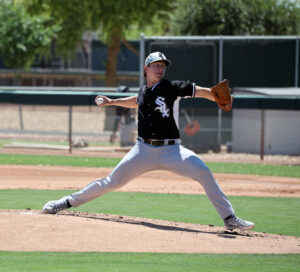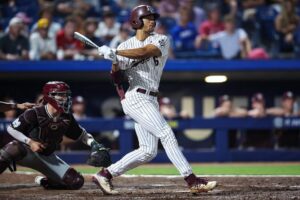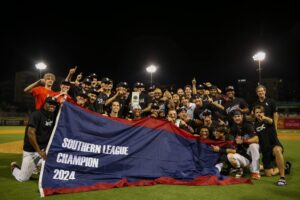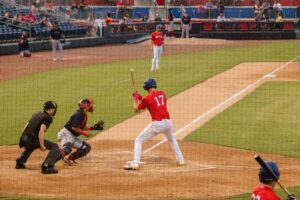Inside the Top 30: A Thrilling Subplot
Our latest Top 30 list is fascinating not only in terms of the overall projections but the subplots that play out beneath the surface. One of the more challenging aspects of the process is separating the pack of outfielders that are jammed up in the latter half of the top 15 of our rankings. The consensus is that Eloy Jimenez and Luis Robert are a couple of the best prospects in the system. But things get dicey when trying to rank the second tier. We are not the only ones that encounter difficulty in discerning the most talented among Micker Adolfo, Luis Alexander Basabe, Luis Gonzalez, Blake Rutherford, and Steele Walker. Opinions on these players not only vary between our writers but with each of the major publications that provide partake in these endeavors.
Micker Adolfo

Micker Adolfo at the dish. (Clinton Cole/FutureSox)
FutureSox Ranking: 7
Baseball America Ranking: 6
MLB Pipeline Ranking: 11
2018 Statistics
Class-A (High) Winston-Salem
Plate Appearances: 336
Strike Outs: 92
Walks: 34
Slash line: .282/.369/.453
Home Runs: 11
OPS: .853
Why he’ll emerge
The 6’ 3” 225 pounder out of the Dominican Republic would be chosen by any Hollywood casting agent to fill the role of a power-hitting right fielder in a movie. In addition to looking the part, he thrills audiences with frequent home runs and a legendary throwing arm. He also got the slash to back up the flash. Since being signed for a whopping $1.6 million as a 17-year-old international free agent, his overall numbers have been on a linear upward trajectory. In a season truncated by injury, he put up a career-best slash line along with an above average OPS while playing his first season as a full-time DH in High-A. With positives like this, you don’t need to hire a detective to understand why many people think Micker will be a box office draw on the South Side of Chicago.
Why he’ll stall
In his quest to transform into a major league level talent, Adolfo faces two familiar villains. Overcoming injury is a classic drama that is played out on almost every professional baseball diamond. He is currently rehabbing from Tommy John surgery and is expected to be back this season. In an article Adolfo self-penned for FutureSox, he did not provide a specific timetable for his return. As a non-pitcher, this injury is not expected to have much of an impact, despite his throwing arm being one of his better attributes. However, Adolfo has suffered through a few injuries in his minor league career making staying healthy a priority.
From a performance standpoint, Adolfo has a proclivity to strike out, posting a 31% ratio in 2017 while reducing that number to 27% in 2018. A rate of about 20% is considered MLB average, so he’ll need to work on putting the ball in play more to be a capable MLB run producer. It’ll be interesting to see if he can continue to decrease his strikeouts while increasing his level of the minors. How he recovers from injury, handles better pitching and improving his contact rate are things to watch for in 2019.
Luis Alexander Basabe

FutureSox Ranking: 9
Baseball America Ranking: Unranked – List Top 10 only
MLB Pipeline Ranking: 9
2018 Statistics
Class-A (High) Winston-Salem
Plate Appearances: 245
Strike Outs: 64
Walks: 34
Slash line: .266/.370/.502
Home Runs: 9
OPS: .873
Double-A Birmingham
Plate Appearances: 270
Strike Outs: 76
Walks: 30
Slash line: .251/.340/.394
Home Runs: 6
OPS: .734
Why he’ll emerge:
After struggling in 2017, Basabe had a breakout first half of the season at Winston-Salem giving White Sox fans reason to believe that the “third piece” in the Chris Sale deal also may manifest himself at the MLB level. Couple that with boomeranging a 102 MPH pitch for a 404 foot home run in the Futures Game and even casual observers took notice.
At a listed 6’0, 160 pounds, Basabe does not have great size, making the power he’s displayed impressive. He adds a speed element to his game that has scouts thinking he could be an above the title star delivering 25 long balls and 25 stolen bases annually while playing a solid center field at his ceiling. He also isn’t afraid to take a walk giving him the astute batting eye that is required at the MLB level.
Defensively, Basabe has the skill set be an everyday center fielder, where he has spent 77% of his time in the minors. If this doesn’t work out, he possesses the arm strength to play the corners making a speedy fourth outfielder at the MLB level a fallback option.
Why he’ll stall:
If Basabe is going to break out of the pack, he’ll need to overcome one of the same villains as Adolfo. He also has a K Rate in the high 20% range. Despite taking walks, he’ll need to make contact more consistently to continue his rise through the system.
Basabe’s stellar first half earned him a promotion to Double-A Birmingham at the halfway point of the season. If he is going to see Triple-A in 2019, he’ll need to improve offensively. His numbers declined by a significant amount after his arrival in Birmingham giving some observers pause about his readiness for reaching the top level of the minors. Basabe will need to prove himself at the dish to avoid becoming another promising talent that flamed out after a few early “hits.”
Luis Gonzalez

FutureSox Ranking: 10
Baseball America Ranking: 9
MLB Pipeline Ranking: 14
2018 Statistics
Class-A (Full) Kannapolis
Plate Appearances: 255
Strike Outs: 57
Walks: 21
Slash line: .300/.358/.491
Home Runs: 6
OPS: .850
Class-A (High) Winston-Salem
Plate Appearances: 287
Strike Outs: 46
Walks: 27
Slash line: .313/.376/.504
Home Runs: 6
OPS: .880
Why he’ll emerge:
The 2017 third-round draft pick out of the University of New Mexico started 2018 in Kannapolis after playing 63 games there in his first season. He likely would have been promoted to start the season, if not for the glut of outfield prospects in the lower minors. He quickly proved too much for the level and earned a midseason promotion to Winston-Salem. In a shocking plot twist, he out-raked himself the latter half of 2018 putting up an impressive slash line without being subject to the high K-Rate that is the nemesis of so many young players. Stack MLB level plate discipline, an increase in home runs, plenty of speed and the defensive chops to stick in centerfield and it’s easy to understand why he has skyrocketed up the charts.
Why he’ll stall:
As a five-tool player, who has proven he has all of them with his performance on the field, it’s tough to find a negative. The only reasons for tempered enthusiasm are having played three years in college he’s a bit old for the level, but even that argument is on shaky ground Other than that, he likely be a gap hitter at the MLB level, but as a speedy center fielder that shouldn’t diminish his chances of becoming a productive player. Whether or not he’s able to sustain his success at the upper levels of the minors and the lack of a standout tool are the only open questions on Gonzalez at this juncture.
Blake Rutherford

FutureSox Ranking: 11
Baseball America Ranking: 8
MLB Pipeline Ranking: 7
2018 Statistics
Class High A Winston-Salem
Plate Appearances: 487
Strike Outs: 90
Walks: 34
Slash line: .293/.345/.436
Home Runs: 7
OPS: .781
Why he’ll emerge:
Blake Rutherford is a true child star. He received a scholarship to UCLA coming out of eighth grade and was a number one draft pick of the New York Yankees before coming to the White Sox in the Todd Frazier deal. After a tough 2017, he put up much-improved numbers including a solid contact rate. In a conference call with bloggers last summer, Director of Player Development Chris Getz commented,
“He hits the ball hard. In terms of average exit velocity, he is one of our top guys. He’s definitely above average for the league. He’s got a real good feel for hitting.”
Why he’ll stall:
With all the improvement Rutherford made in 2018, his power numbers failed to come along with it. Questions about his ability to play center field also fuel his detractors. To stick as a corner outfielder, he’ll need to start launching balls out of the park be viable at the MLB level.
With teams carrying as many as 13 pitchers, fourth outfielders tend to play all three positions, and the DH role requires top-level power, making a reserve role questionable without being a consistent along ball threat. If he is able to start getting lift on the ball with his previously mentioned exit velocity, then he has a chance to be one of those rare child stars that make it as an adult.
“His launch angle is increasing. A guy that hits the ball that hard and has a feel for hitting, you can be optimistic that power is going to come in the future,” said Getz.
Steele Walker

FutureSox Ranking 15
Baseball America 10
MLB Pipeline 12
2018 Statistics
Class-A (Full) Kannapolis
Plate Appearances: 126
Strike Outs: 29
Walks: 8
Slash Line: .186/.246/.342
Home Runs: 3
OPS: .613
Note: Walker also played four games with AZL and nine at Great Falls.
Why He’ll Emerge:
It’s difficult to get a read on Walker based on his abbreviated time with the White Sox organization. The 46th overall pick in 2018 came to the team exhausted and injured (oblique) after the college season. This makes it problematic to draw any conclusions based on the poor numbers he posted at Kannapolis. At the time of the draft, he was considered one of the more polished bats. Couple that with his success in wood bat leagues and there are reasons to be optimistic. He makes outstanding contact, has decent speed and should hit for a little power. It’ll be easier to gauge Walker’s outlook by the mid-point of 2019.
Why He’ll Stall:
His 2018 performance can’t be entirely dismissed as a second-round pick is expected to perform better than his numbers. Beyond that the same questions that plagued him coming into the draft remain. Does he have the speed to stick in center field? If not, does he have the power to play the corner? Right now, Walker has more questions than answers. Those are coming soon enough.
Outlook
With all of these players having similar skill sets, question marks and experience, how do you separate them? As you can see, we have them ranked very closely, and the other services have some different opinions. For us, Adolfo’s power and arm strength separate him from the group. If everything pans out, he’s a prototypical MLB right fielder.
Separating Basabe and Gonzalez is much more difficult. Both have all five tools. With dropa in production at times, Basabe’s ability to handle the upper levels of the minors is in question, though he has consistently been playing quite young for level. He could be a boom type player, given his speed and power. If not he has a floor of a speedy fourth outfielder. Conversely, he may not have the hit tool to handle quality pitching making the possibility of him stalling out at Double-A a realistic outcome.
While Gonzalez has demonstrated all the tools at the lower levels, he does not have the one standout skill that differentiates him from the rest of the pack. He still needs to prove it at the upper levels of the minors. Basabe gets the nod due to his greater upside, but that could change faster than the ending of an M. Night Shyamalan film.
Due to his projection as a corner outfielder, Rutherford ranks a cut below. If he’s able to translate the exit velocity that Getz mentions into home runs, then he’ll leap forward. At SoxFest, it was noted that he’s bulked up this offseason, and that could factor into the power profile as well. There are plenty of reasons to believe he’ll start sending balls into the seats shortly, but until it’s seen in live game action, he remains in the lower portion of this grouping.
While Walker’s tools have other rating services’ jaws dropping, the team at FutureSox wants to see it translate to on-field production before putting him ahead of these promising and more proven players.
Now it’s your chance to play the Rotten Tomatoes reviewer. Agree with our rankings? Disagree? Got a favorite to emerge from this logjam? Is there someone you just don’t think has what it takes? Place your comments in the box below to facilitate further discussion.
Want to know right away when we publish a new article? Type your email address in the box on the right-side bar (or at the bottom, if on a mobile device) and click the “create subscription” button. Our list is completely spam free, and you can opt out at any time.







The excellent discussion in the article makes it difficult to choose any one of these players over another. Strictly speaking of their fit in the White Sox future core could make it a little easier. Assuming that Eloy Jimenez is the long term White Sox LF and Luis Robert their fixture in CF, that would leave RF and the 4th OF spot open.
The current best prototypical fit in RF would be Micker Adolfo with his plus power and arm. Of course, that would also give the White Sox an all right-handed hitting starting OF which might not be ideal looking at their likely future infield with right-handed hitting 2B Nick Madrigal and SS Tim Anderson also batting from the right side. Among these, only switch hitting 3B Yoan Moncada would offer a decent bat from the left side. That still leaves the catcher and 1B/DH position open to adding some left-handed pop. That being said, I’m still not sold on lefty-hitting Zack Collins as an everyday starting MLB catcher although he could conceivably slot in at the 1B/DH positions. I’m also a big fan of Jose Abreu and would still like to see the White Sox extend him which would add yet another right-handed bat to the 1B/DH mix.
This is why I am hoping the White Sox make Bryce Harper their priority free agent signing this offseason. As much as I like what Manny Machado brings to the table, Harper’s elite left-handed OPS bat fits better into a future White Sox batting order. Signing Machado also likely means that either Anderson or Moncada will not become a White Sox foundation piece once Madrigal makes his MLB debut at 2B.
Getting back to the 4th OF spot, that would necessitate a player being able to handle all three OF spots proficiently on defense. That gives Luis Alexander Basabe and Luis Gonzalez the edge over the other candidates. If the White Sox strike out on Harper this winter without adding another left-handed bat via a trade (would love to see them swing a trade for Alex Verdugo) then Blake Rutherford just might become the team’s best bet to fill the RF spot provided he can show some pop in AA and AAA in the next two years.
Yes, you certainly bring up some interesting points. The sad truth is that all of these players won’t pan out and all of them won’t be with the team because of some of the issues your bring up. They need to develop as many as possible then consider trades or free agent signings to address things such as lineup balance or other holes that may exist in the roster.
Development is always important whether you keep a prospect or use him as future trade bait. However there are two game-changing FA’s available this offseason and at the right age who the White Sox are deeply engaged in. Clearly the organization is making each a priority this offseason with all of these OF prospects discussed here still a year or more away from any potential MLB debut.
My argument is that the White Sox should prioritize Bryce Harper over Manny Machado if they hold true to Rick Hahn’s suggestion that it’s highly unlikely the team would sign both this offseason.
Additionally, Hahn also inferred that other acquisitions might occur before opening day including the potential for a trade that might conceivably involve White Sox prospects for other controllable talent outside the organization, hence my hope for an Alex Verdugo deal with the Dodgers. I might actually prefer his high BA/OBP left-handed bat and 80-grade arm in RF over what Harper might provide and definitely more than any White Sox OF prospect discussed in this article. After enduring the historic amount of whiffs on the South Side last season I can’t wait for the arrival of a contact hitter like Nick Madrigal and also feel that Verdugo would be a similar bat with much more power potential. I don’t subscribe to the modern theory that every player needs to be judged on their launch angle and exit velocity.
I have always preferred a lineup with traditionally assigned roles including a speedy high OBP leadoff hitter capable of high SB totals (Luis Robert), a patient high OBP “grunt” contact hitter with speed in the #2 hole (Nick Madrigal), my best all-around around hitter in terms of triple slash batting 3rd (Eloy Jimenez) followed by my best remaining power/RBI bats hitting 4th and 5th. I also prefer a hitter with decent speed hitting 9th and not clogging the base paths for my #1 and #2 hitters as the game progresses (Tim Anderson). I also like a balanced lineup in terms of staggering lefty/righty hitters as much as possible which presents problems to the opposing manager with his latter game pitching changes. Switch-hitters are ideal provided they are proficient from both side of the plate, something that Yoan Moncada has yet to demonstrate in his professional career.
There are certainly people who agree with you. For some reason, there doesn’t seem to be as much interest in Harper. Maybe he’d prefer to stay in the national league. An outfield with him in Right and Eloy in Left for the next ten years, sounds good to me.